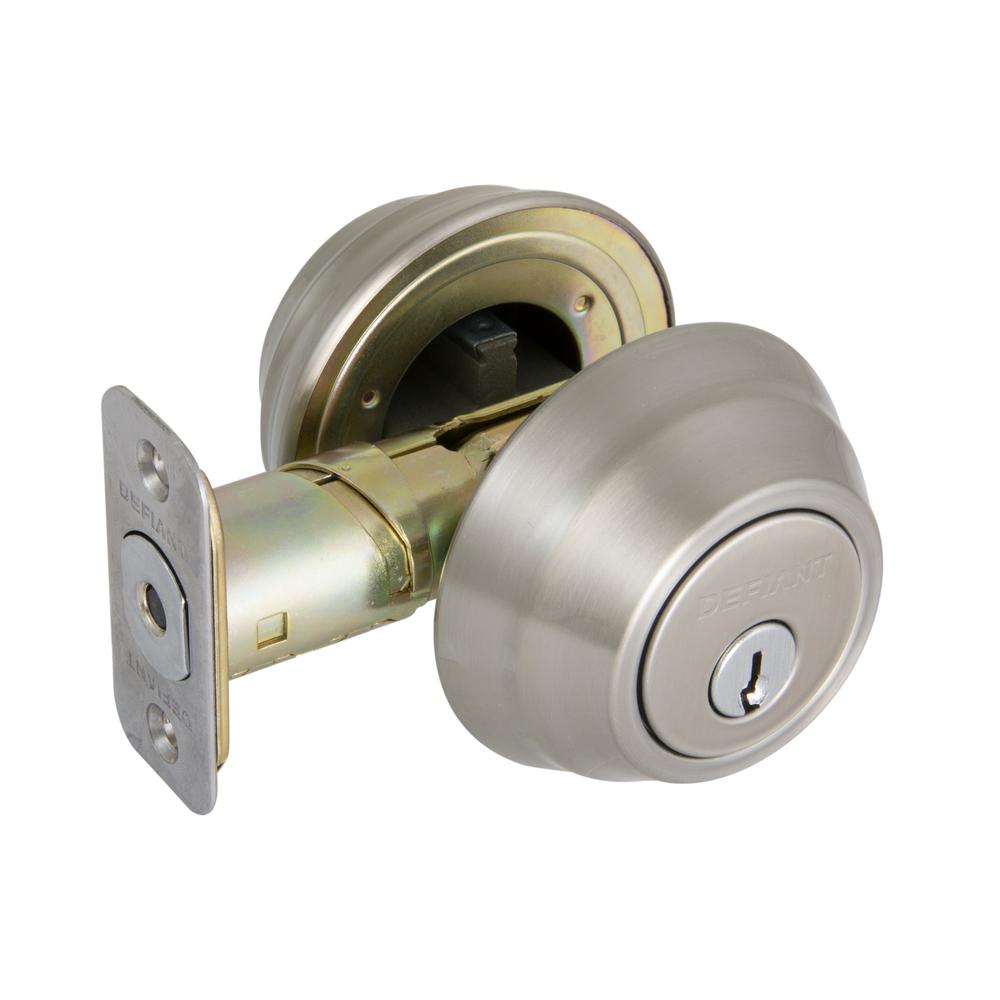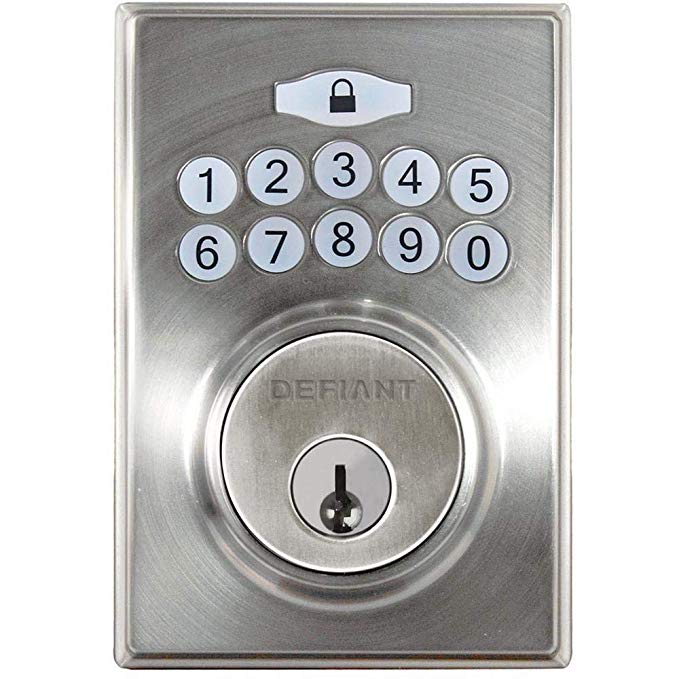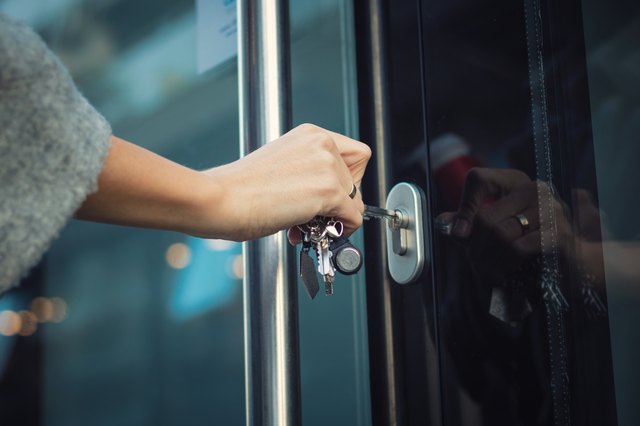
Did you know that the 3rd most common brand of residential locks in America has almost no information about it online? Unlike the other popular brands, it doesn’t have a Wikipedia page, reviews are almost non-existent and most surprising is that it doesn’t even have an official website! And yet millions of people in America have a Defiant lock installed on their doors. I thought it would be a good idea to do some digging and uncover some of the mystery surrounding this mysterious brand of locks. This is currently the most comprehensive article written about Defiant locks. If you’re not sure whether your locks are made by Defiant, you can find out pretty quickly by looking above the keyhole of your deadbolt, or the latch at the side of the door if it’s a doorknob, both will have “Defiant” stamped on them.
Disclaimer: I’m not affiliated with Defiant or Home Depot in any way. No one has paid me to write this article. In this post I’m presenting my opinions based on my own independent research and my years of experience as a professional locksmith. I accept no liability for any consequences of any actions taken based on the information provided.
Who Makes Defiant Locks?

Defiant is one of only 3 brands of locks sold at Home Depot which makes it one of the best-selling locks in America. As a Locksmith, I run into Defiant locks on a daily basis, so I found it strange when I couldn’t find any information about them online. If you try searching for Defiant’s website the results will take you to the Home Depot’s website – the brand’s only retailer. That’s because Defiant locks are actually made exclusively for Home Depot by the Taiwanese manufacturer “Taiwan Fu Hsing Ind. Co. Ltd”, and have been for almost 25 years, according to one of the brand’s promotional videos.
Remove the doorknob or deadbolt from the door to access the lock cylinder. In most cases, you do. How to rekey a lock 101.
Which Locks Are Made by Defiant?
Defiant offers a standard line of residential locksets which includes a single sided deadbolt and a double sided deadbolt, 3 types of doorknobs (passage, bathroom and entry in 2 different designs) as well as a residential keypad lock. Each lock can come in one of 3 finishes: brass, silver or black, and can be purchased separately, or in a combo of a matching deadbolt and doorknob. There are also double combos available of 2 deadbolts and 2 doorknobs all keyed alike providing a decent low cost solution if you’re looking to change all the locks on an apartment or a small house without needing to get some of the locks rekeyed. Defiant locks come with a lifetime warranty from The Home Depot, and although the warranty will protect you from wear and tear, it doesn’t necessarily mean that the locks are secure.
Technical Specifications
In this article I’m not going to talk much about the security aspect of Defiant locks as I already covered the topic in depth here, but I will briefly mention its security features. The cylinder of both the Defiant doorknobs and deadbolts contains 5 sets of pins, 3 of which are security spool pins. The deadbolt is equipped with a drill resistant plate making it slightly harder to drill the lock open, however, as can be seen in this video – it’s pretty easy to remove it. Overall Defiant locks provide basic security at a low price but will hardly pose a challenge for an experienced intruder.
Defiant locks share the same type of keyway with the Kwikset brand, which means that a Defiant key will fit into a Kwikset lock and vice versa. If all the locks on your house are Kwikset locks, you can still buy a Defiant lock and match it to work with your current house key.
For a more in-depth review of how secure Defiant deadbolt are check out our comprehensive lock comparison article.
I hope that in this article I managed to shed some light over the Defiant brand and give an informative overview of the brand, its locks and their features.
If you liked this article and want to be kept up to date with the latest home security trends don’t forget to like our facebook page, twitter and subscribe to our YouTube channel.
If you have any questions about Defiant locks send us a message on Facebook or Twitter, we make sure to read and reply to all the questions.
Rekey vs. Changing your locks – Front Range Locksmith
June 8, 2016
5 Tips to Never Get Locked out of your House Again
January 22, 2016
Thinking about changing out the locks to improve your home's security? Start here for a better grasp on when—and how—to rekey rather than replace them altogether.
Photo: istockphoto.com
Key rings can get crowded (and heavy!) fast, when you consider all that you load up on them: keys for your car, front door, side door, back door, mailbox, maybe even your mother-in-law’s, and a handful of miniature rewards cards sized and punched to conveniently hang. Carrying that whole lot will cause your pockets to jingle with each step and you to waste precious minutes every day fumbling for the correct copy to the door or locker you are interested in opening. Fortunately, rekeying a few of your locks offers an easy, affordable, and even DIY solution can lighten your load. Understand when, why, and how to rekey a lock with this handy guide.
What it Means to Rekey a Lock
A pin and tumbler lock—the kind of lock found on locking doorknobs and deadbolts—contains a steel cutaway that holds a cylindrical plug and a number of springs and pins that allow a specific key shape to turn in the lock. In order for a key to turn the locking mechanism, the configuration of the pins must match the depth of the unique grooves on that key.
When you want the lock to open with a different existing key—say, so you no longer want to use separate keys to enter the front, back, and side doors—the lock must be disassembled and the pins, which are of various heights, removed and replaced by new pins that match the cuts and grooves in the new key.
Photo: istockphoto.com
Reasons to Rekey a Lock
As mentioned, rekeying makes most sense for homeowners who prefer to have a single key that opens all of their door locks to the home or apartment. This process can lighten a full key ring to a few essentials, taking up less space in your pocket or bag as well as less time spent searching for the right one.
However, rekeying a lock can also improve a building’s security measures. After a new home construction—during which a number of people might have copies of door keys, including contractors, subcontractors, and inspectors—new homeowners may want to make sure they have the only keys to their home before they take possession.
Likewise, it’s also a common practice for landlords and property managers to have door locks rekeyed every time a new resident moves in. Whether you’re moving into a previously owned home or have simply misplaced a set of spare keys, rekeying is an alternative to replacing the lock altogether that provides the peace of mind that comes with knowing no one else has a key to your home.
When to Replace a Lock Versus Rekeying
Both replacing and rekeying a lock effectively change out a lock to limit access, but there are some cases in which you have to go through the motions of both processes.

- If you’ve lost the key that opens your existing lock(s), you won’t be able to disassemble the lock for rekeying. First replace the lock.
- Rekeying won’t fix a worn or damaged lock. You’ll probably have to replace the lock with a cracked or warped locking mechanism soon, anyway, so consider doing so first. Then, if your goal was to change the locks so that you have the only key, you’re set; you only need to rekey if you want multiple locks to share one key.
- When rekeying multiple locks to fit a single key, all locks must first have been made by the same manufacturer. For example, if your front door lock is a Schlage, the other locks you want rekeyed to match must also be made by Schlage. You cannot rekey a Kwikset or Sargeant lock to open with the same key as a Schlage lock, because different brands of locks have different size keyholes that only accept their own keys. If you’re dealing with multiple lock brands, you’ll need to decide on one and replace the others to match this brand before rekeying.
Photo: flickr.com via taubinphoto
Options for Rekeying a Traditional Lock
Call a locksmith.
This is the most expensive option. A locksmith will usually charge a set rate for a service call (often between $40 and $100) and then charge you an additional fee (potentially $10 to $30) for every lock you want rekeyed.
Take the lock (locking knob or deadbolt) to the locksmith, local lumberyard, or hardware store.
You’ll have to remove the lock from the door for this option and bring the key that currently opens the lock, but eliminating the house call makes this an inexpensive option. Expect to pay around $5 per lock.

Purchase a rekey kit, made specifically for your brand of lock, and rekey it yourself.
If you cannot find a local store that will rekey a lock inexpensively, you can purchase the necessary tools to rekey the lock. Purchase a rekey kit—for a single lock or up to five locks of the same brand—that matches the brand of lock you want to rekey.
A rekey kit for a single lock typically costs between $12 and $25 dollars, depending on the brand and type of lock. Hardware stores carry rekeying kits for some of the most common lock brands, but they can also be ordered from lock manufacturers and large online retailers like Amazon.
Home Depot Rekeying Locks
The kit contains everything you need to rekey the lock: tiny picks and tweezers, a key gauge (which is used to determine the depth of the cutouts on your new key), an assortment of pins and springs, to replace the existing ones in the lock, and any other tools you’ll need to dissemble and reassemble the lock.
Rekeying Smart-type Locks
Some people—including apartment managers, owners of large office buildings, even regular Airbnb hosts—find it necessary to rekey locks frequently. To address this need, many lock manufacturers have introduced locks with smart-type rekeying technology that enables a manager to rekey the lock in less than a minute and without any disassembly. Instead, the lock’s design uses a special master key to facilitate the quick and easy rekeying, with the smart rekeying process varying from manufacturer to manufacturer. If you’re someone who would benefit from frequent rekeying, exploring today’s options could simplify your life and still tighten security at home.
